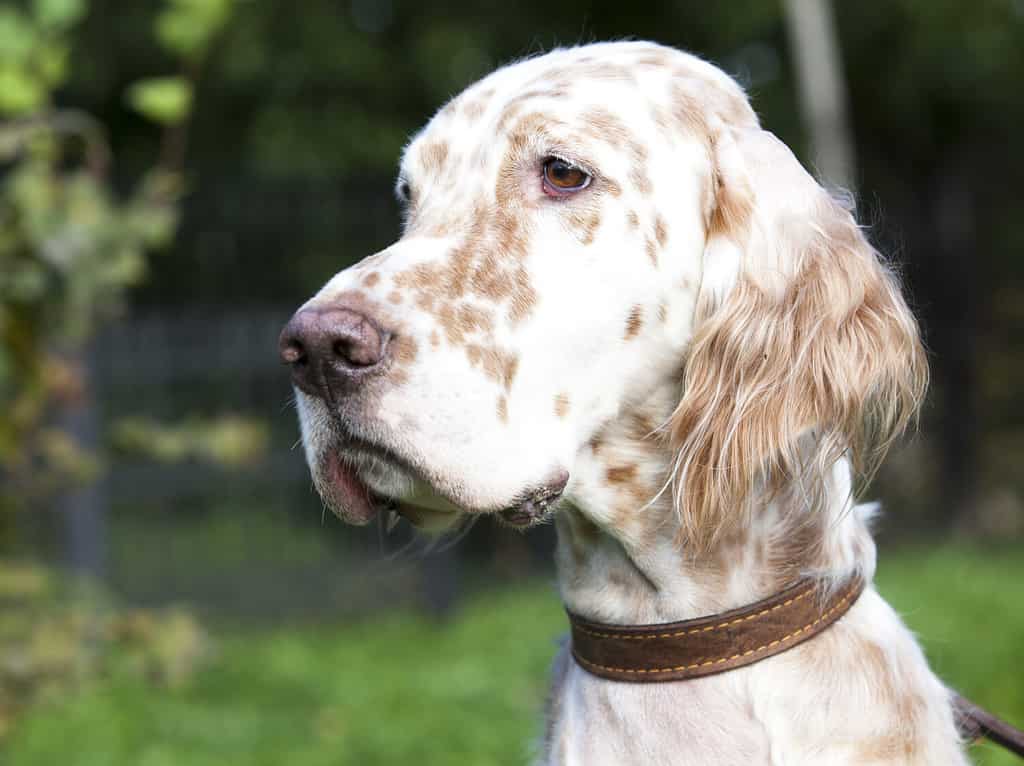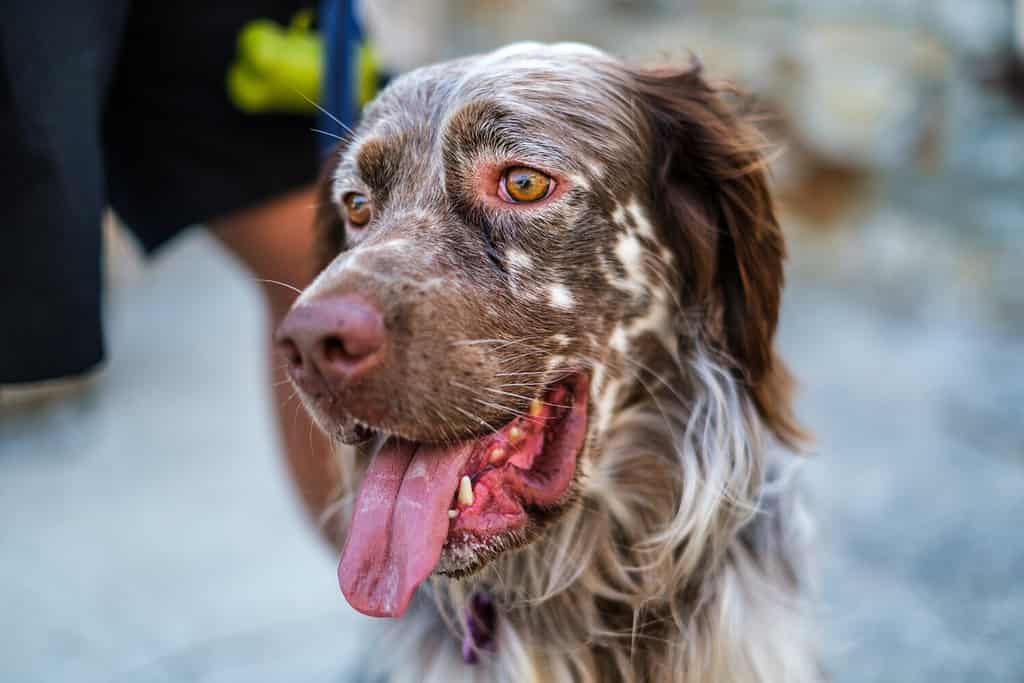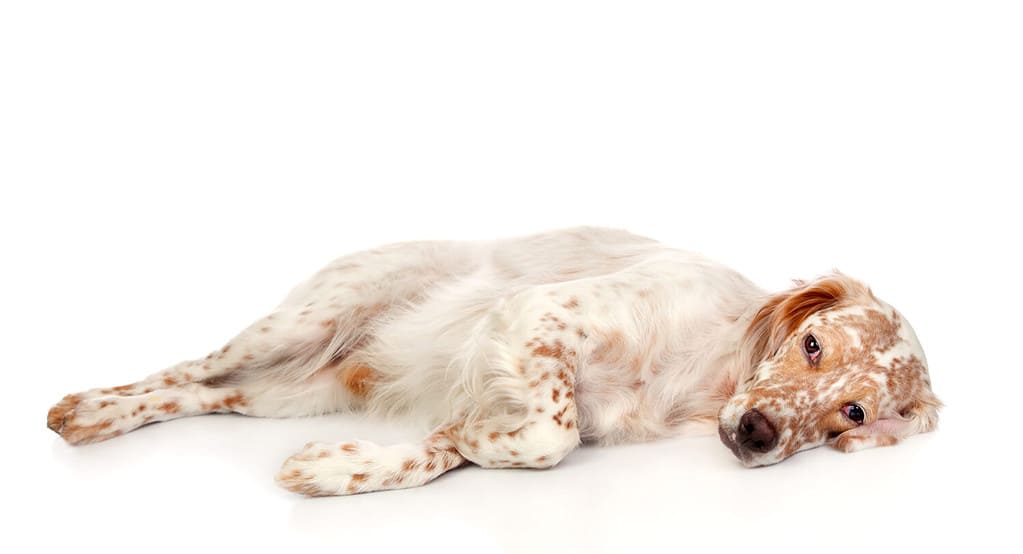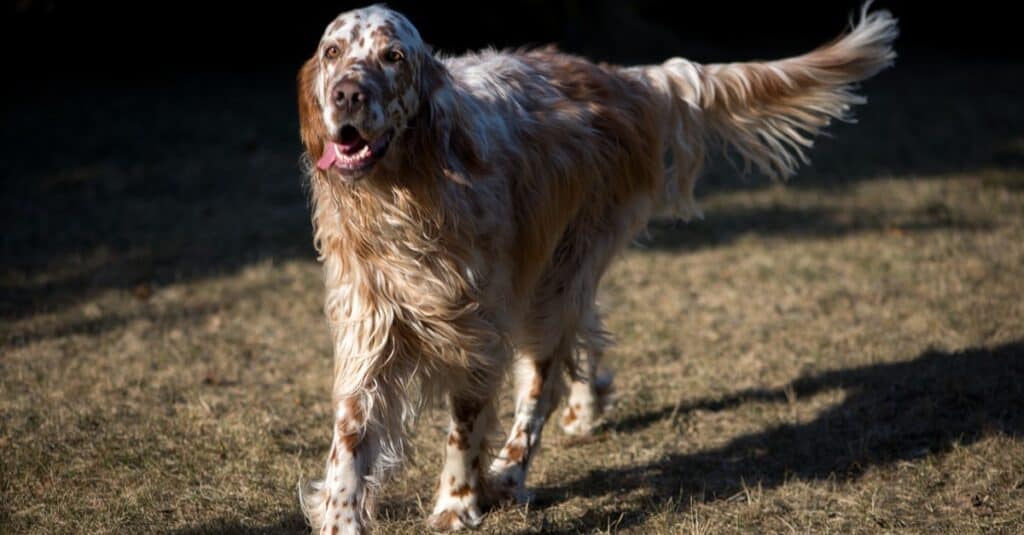English Setter Summary
English setters are medium-sized dogs with loving personalities suited for family life. They get along well with other dogs, children, and sports. These dogs have a speckled coat that can be white with a black or grey pattern, orange, yellow, or even brown. It is called a Belton pattern after the English village where the breed originated in the early 1800s. They are excellent hunting dogs and were bred to “set” to flush birds out.
English Setter Growth and Weight Chart by Age

English setters usually have a long oval face with a square-shaped muzzle.
©Liliya Kulianionak/Shutterstock.com
While each dog is a little bit different, it can be helpful to know what to expect when it comes to English setter growth. Typically, new puppies stay with their mothers for the first 8 weeks of life. They also grow and develop rapidly during this time. Because these dogs originated in England and are recognized by the Royal Kennel Club (as well as others), we’re sharing their expected weight in kilograms. You can easily convert the weights to pounds by multiplying by 2.2 to get their weight in pounds.
| Age | Male Weight (in kg) | Female Weight (in kg) |
|---|---|---|
| 3 months | 9 – 11.4 | 7.3 – 9.7 |
| 4 months | 12 – 15.1 | 9.6 – 12.8 |
| 5 months | 14.7 – 18.5 | 11.9 – 15.6 |
| 6 months | 16.7 – 21.2 | 13.4 – 18 |
| 7 months | 18.2 – 23.8 | 14.8 – 20 |
| 8 months | 19.9 – 25.3 | 15.9 – 21.2 |
| 9 months | 20.9 – 26.9 | 16.3 – 22.2 |
| 10 months | 21.3 – 27.9 | 17 – 23.1 |
| 11 months | 22 – 28.5 | 17.2 – 23.9 |
| 12 months | 22.3 – 29 | 17.5 – 24.2 |
| 2 years | 23 – 30 | 18 – 25 |
When Will My English Setter Stop Growing?
Most English setters reach their adult size around 16 to 18 months old. However, it’s important to note that just like people, every dog is unique. Some grow and mature faster than others. Typically, males are larger than females of the same age. There is also some fluctuation and it’s not unheard of for some females to be larger than some males. Both males and females eat three small meals per day as puppies and two larger meals of standard dog food per day as adults.
One great way to keep track of your dog’s growth is to schedule regular visits to your vet. They can help identify if your setter is a healthy weight as well as any other potential health issues. If your setter is gaining too much or too little weight as they grow, the vet can recommend changes to their diet or lifestyle as well as rule out more serious health issues.
Growth often starts to taper off starting around 9 or 10 months old. Before that, your puppy will gain weight and become larger quickly. You may notice a big difference month-to-month or even each week. As they get older, however, this growth slows down. By the time they are one year old, your puppy is pretty close to their adult size. They’ll likely gain less than a pound overall after that. Of course, keep in mind that these are estimates and each dog is unique. If your English setter has other breeds in their ancestry, that can also impact their size as well as other characteristics.
It’s important to know that even once they reach their adult size, their bones are still maturing and hardening all the way up until they are around two years old. Playing too rough with a young English setter can result in them becoming injured. So be careful with your puppy
How Big Will My English Setter Be When It’s Fully Grown?

Male English stters tend to be bigger than females.
©Stefano Benanti/Shutterstock.com
Adult male English setters are around 29.5 to 36 kilograms or 65 to 80 pounds. Females are usually a bit smaller, around 20.5 to 25 kilograms or 45 to 55 pounds. Females are more petite with smaller faces and bodies overall. Most males stand between 25 and 27 inches tall when measured at the shoulder. Females are a bit smaller, often between 23 and 25 inches tall.
The Biggest English Setter Ever Recorded
While he may not be the largest, one English setter in the late 1800s certainly gained notoriety for being the most famous. Count Noble was an English setter who lived with his owner in Pennsylvania between 1879 and 1891. He was a good hunting dog and did well in dog shows. He also passed on many of the most desirable English setter traits to his many offspring. When Count Noble died, the New York Times ran an obituary for him. He eventually found his final resting place in a preserved display at The National Bird Dog Museum in Grand Junction, Tennessee.
When Should My English Setter Be Spayed or Neutered?
According to the English Setter Association of America, you should spay or neuter English Setter puppies around one year old. The organization cautions owners against trying to breed dogs unless they are able to give the time and effort required to do so responsibly. If you do not want to or are not able to breed puppies, you should spay or neuter your pet. Not only does this keep any surprises from occurring, but it is also better for their health and well-being.
Of course, you should talk to your vet before going through the procedure to make sure that it is the right choice for your dog and situation. Other health issues can make it necessary to delay spaying or neutering to address other needs first. Typically, the procedure can be done in the office and only requires minimal follow-up afterward, which can often be done at home. If there are complications or your vet wants to monitor your dog longer, they may keep them for observation in the office. You can talk to your vet ahead of time to know more about what to expect.
When Should My English Setter Be House Broken?
In general, puppies potty train best between 2 and 3 months old. This often corresponds to the time when an English setter puppy comes into your home. This transition can be a good time to teach them how to go to the bathroom in their new environment. Sometimes it depends on the individual temperament of the puppy. If your new dog is struggling with transitioning to a new home, adding potty training to the list might be too much.
As a breed, English setters prefer not to be around their own urine and waste. They’ll learn quickly that going outside to do their business is the best option. Compared to some other breeds, English setters are sanitary and easy to house train. Of course, this can vary by dog.
When Should My English Setter Stop Eating Puppy Food?
As your English setter’s growth starts to level off, you can transition them from puppy food to adult dog food. Puppy food is formulated to support their growth and development during those first 6 months to 1 year. By 1 year, most dogs are nearing their adult weight and size. Their nutritional needs shift as well. By the time they are 16 to 18 months old, almost all English setters are fully grown.
If you aren’t sure when to switch, talk to your vet. Not only can they provide guidance on when to transition but they can also help by recommending foods to meet the needs of your particular dog. If your dog tends to need more of a certain nutrient to support their coat, teeth, joints, or any other aspect of their health, finding the right dog food can make this easier.
When Will My English Setter Start Losing Teeth?
Just like human children, puppies lose their baby teeth and gain adult teeth. This often happens between 6 and 8 months old. Some puppies lose a lot of teeth at once while others take longer to go through the whole process. You can talk to your breeder to see what the experience was like for your puppy’s parents. This can give you an idea of when your puppy might start losing baby teeth.
During teething, chew toys are a great way to keep your puppy comfortable and reduce unwanted chewing. Make sure that they are soft enough for teething puppies. Some chew toys made for adult dogs might be too rigid.
When Should I Start Training My English Setter?

You can train your English setter as a hunting dog.
©janveber/Shutterstock.com
English Setters are trainable but aren’t known for being great working dogs. However, they are bred to be hunters. The best training regimens rely on these natural instincts. They like play and activity, so make sure to build in plenty of exercise and movement to your day. Many behavior issues that you might want to train your dog not to do could be signs that they just aren’t getting enough exercise and exertion.
Generally, English setters want to please their owners and respond well when they have a strong, positive bond. They like getting clear directions and commands but don’t always cooperate when the training is overly harsh. You can start training around 4 months old and socialize them with other dogs and people. Just watch to be sure that they are safe as puppies, especially around larger or more dominant dogs.
English setters are great around kids, families, and other dogs. You likely won’t need to devote much time to training them not to be aggressive. However, each dog is different. If you aren’t sure where to start, talking to a dog trainer can help you identify what to do.
English Setters as Hunters
If you want to train your English setter as a hunting dog, this requires special attention and knowledge. You’ll have to teach them specific commands as well as get them used to the environment. One of the first things that you should do, often around 4 months old, is get them used to the sound of gunfire. Hunting clubs are a great way to introduce your dog to the sport as well as get tips from experienced hunters with dogs. Decoys are another great tool that will help you train a hunting dog.
What Commands Should I Teach My English Setter First?
“Sit” and “stay” are good commands to teach any dog. You can begin when your puppy is between 3 and 4 months old to get them used to the idea. Expect to see some real progress around the 4 or 5-month milestone. “Come” is another helpful command that you can use. It is useful for both you and your dog, especially if you take them out on adventures or to socialize at a dog park.
If you plan to train your English setter as a hunting dog, “heel” and “release” are two excellent commands to teach as well. “Heel” requires your dog to walk close to you, which may be necessary for their safety as well as the success of the hunt. After they retrieve a bird, “release” cues them to release it to you.
When Will My English Setter Calm Down?
English setters move through the puppy stage and become adults around 16 to 18 months. This often corresponds to the age when they calm down and become less boisterous. Each dog has its own personality, though. So your dog might be naturally more calm or more energetic. As a breed, English setters are calm but like to play. When it’s time to play or run, they do so with a lot of enthusiasm, even as adults. But they are also gentle and lovable when given the chance.
Common Health Issues Your English Setter Might Experience
Health issues that can occur in English setters include hip dysplasia, elbow dysplasia, and hypothyroidism. Knowing that the breed is more susceptible to these conditions, you can work with your vet to choose a food that supports their joint and thyroid health.
These dogs benefit from plenty of exercise. They were bred to be very active and go along on hunts in the outdoors. Even if you aren’t keeping an English setter as a hunting dog, it’s still good to give them plenty of places and chances to run around outside. If they stay sedentary too often, they may become obese and have health complications related to weight.
Pictures of English Setters as Puppies

English setter puppies don’t have the characteristic Belton pattern that they will develop as they grow.
©Minko Peev/Shutterstock.com
Pictures of English Setters at 6 Months

English setters go through a lot of growth as young puppies and look much more like adults by the time they reach 6 months old.
©Gelpi/Shutterstock.com
Pictures of Fully Grown English Setters

Adult English setters have long hair that requires frequent brushing to stay in the best shape.
©Zelma Brezinska/Shutterstock.com
Other Dog Breeds Similar to English Setters
Irish Setters
A breed closely related to the English setter is the Irish setter which also makes for a great hunting companion. Irish setters can be more playful than their reserved English counterparts but both breeds love activity and exercise. Irish Setters have striking solid red coats.
English Pointer
Pointers are bred to “point” with their entire bodies during a hunt while setters will “set,” or lie low on the ground to stay stealthy. Both behaviors come down to training as well as the disposition and breeding of the pointer or setter.
Brittany
These are a type of setter and tend to be a bit smaller than English setters. Brittany’s used to be classified as a type of spaniel before they gained recognition as an independent classification.
The photo featured at the top of this post is © iStock.com/Michel VIARD
Ready to discover the top 10 cutest dog breeds in the entire world?
How about the fastest dogs, the largest dogs and those that are -- quite frankly -- just the kindest dogs on the planet? Each day, AZ Animals sends out lists just like this to our thousands of email subscribers. And the best part? It's FREE. Join today by entering your email below.
Thank you for reading! Have some feedback for us? Contact the AZ Animals editorial team.






